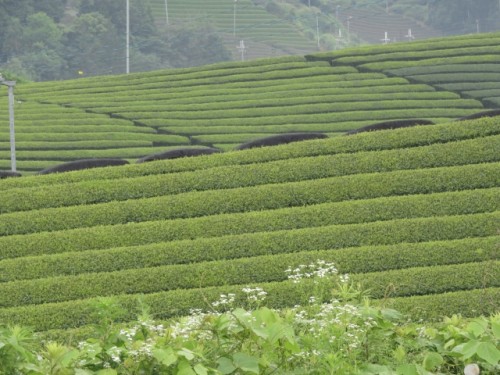Terroir – a French word that refers to the environmental factors that influence a crop’s characteristics – may be an expression which is more familiar to wine buffs. Yet, wine buff or not, have you ever considered how the ‘terroir’ could affect the flavour of your Japanese tea?

As a country renowned for its tea, it is probably unsurprising that there are numerous tea production regions throughout Japan. Varying climate conditions and soil composition give rise to an array of different flavours of green tea to enjoy.
The ideal environment for growing tea is in mountainous regions with bountiful rainfall (over 1,300 mm) spread throughout the course of the year. Mountainous regions also have the added benefit of mist, which helps to protect the delicate tea leaves from the frost that comes as a consequence of low nightly temperatures. Furthermore, another essential component of fruitful tea production, is a marked difference in temperature between night and day.
Shizuoka: The Largest Tea Region
First and foremost, is the largest and leading region for tea agriculture, Shizuoka. This prefecture produces over 40% of all the tea grown in Japan. Neighbouring Mount Fuji, the expansive tea fields mainly grow sencha, the classic Japanese green tea. Shizuoka has risen to its No.1 position partly in thanks to the discovery of a new treatment method, Fukamushi, developed during the Meiji era (1868-1912). Immediately following harvest, the leaves are steamed over vapour, helping to maintain their freshness. Sencha produced in this area has a distinctive, slightly bitter quality, with an accompanying rounded softness.
Kagoshima: The Nutrient-rich Tea Region
After Shizuoka, the second leading region for tea production, at 25%, is found in southern Japan, on the island of Kyushu, in Kagoshima. Here, there is a subtropical climate with strong sun throughout most of the year. Due to a volcanic eruption 24,000 years ago, the soil has a rich mineral content high in white ash. Soil composition and chemistry can of course have a big impact on tea flavour. In Kagoshima, the combination of hot climate and mineralised soil results in tea with a fresh aroma and subtle fruitiness.
Gifu: The Strong Tea Region
The Gifu tea region mainly covers the area of Hida, including the enchanting UNESCO World Heritage site Shirakawa-go. Nestled in the Japanese Alps with peaks reaching over 3,000 m, this fertile area grows tea with exceptional depth of flavour.
Kyoto Uji: The Original Tea Region
Last, but certainly not least, is Kyoto – the origin of tea culture in Japan. Kyoto is where Buddhist monks developed their appreciation of the tea they brought from China. Consequently, the Kyoto tea region, Uji, benefits from a long history of expertise and skill. New processing methods for Sencha and Gyokuro (speciality green tea) have been developed in Uji since the Edo period (1603-1868).
Along the borders of Kyoto, where the river Uji descends from the mountains, the Uji region is perfectly situated for tea production. Foggy, misty mornings protect the leaves from frost, the enemy of the tea plant. In this ideal climate, the soil is well-drained and aerated. Hence, a real intense flavour, rounded sweetness and pleasant aroma are brought out in the tea. Kyoto and Uji are also especially renowned for their matcha (powdered green tea).
Develop Your Tea Senses
Next time you pour a cup of tea, take a look at, or research, its terroir. While you’re drinking, try to distinguish any unique qualities in the tea, pleasant or disagreeable. Perhaps you could even choose a specific type of tea and collect the same tea from different regions. Be sure to prepare the teas in a similar fashion for a fair analysis. Take notes, compare and contrast. Through discovering the enlightening world of the tea sommelier, you could also observe your own personal preferences. Finally, and above all, enjoy a good, warming cup of tea.














No Comments yet!